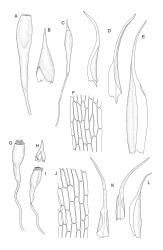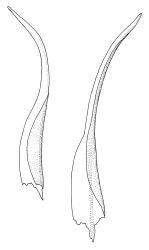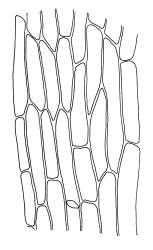- ≡ Stirtonia mackayi R.Br.bis, Trans. & Proc. New Zealand Inst. 32: 149 (1900)
- = Trematodon weymouthii E.B.Bartram & Dixon, Bot. Not. 1937: 65 (1937)
Plants yellow-green. Stems 2–6 mm, unbranched. Leaves erect-spreading and ± twisted, sheathing below, contorted when dry, abruptly tapered from an oblong, concave and strongly sheathing base to a narrow subula that is completely filled by the costa and c. ⅔ the total leaf length, entire, mostly 4–7(–8.5) mm (in perichaetium) but much shorter below (≤2 mm). Laminal cells of leaf base mostly 75–105(–120) × c. 18–20 µm. Costa (in leaves immediately below the perichaetium) occupying c. ⅙ the width of the base, filling the subula, in cross-section (lower subula) with abaxial and adaxial bands of smaller, firm-walled (non-stereid) cells.
Apparently dioicous. Setae 8–15(–23) mm, slender, nearly straight or weakly flexuose, yellow; capsules c. 3.8–5.0 mm, straight or curved, erect or inclined, with the neck equal or distinctly longer than the cylindric urn, strumose; exothecial cells elongate, not polygonal; annulus persistent at mouth; operculum rostrate from a conic base, c. ⅓ the capsule length. Peristome reduced to a hyaline membrane that scarcely exceeds the mouth, sometimes pigmented and with some striations at its upper edge. Calyptra cucullate or occasionally ± mitrate, covering the operculum and the urn. Spores (48–)54–66(–75) µm, coarsely baculate.
Sainsbury 1955, pl. 14, fig. 1.
NI: N Auckland (Awanui), S Auckland ("Waikato bogs"); SI: Nelson (Collingwood, Mōkihinui, Granity, Whitehorse Bay, Four Mile River), Westland (Taylorville), Southland (Awarua Bog); St.
Australasian. Tasmania*. Reported from mainland Australia by Scott & Stone (1976, p. 164).
Apparently restricted to lowland sites; usually on peat and often in pākihi; a large fraction of collections were made from recently burnt sites. From near sea level (Awarua Bog, Southland L.D.) to c. 150 m; often associated with Campylopus introflexus.
The Berggren collection recorded by Sainsbury (1955, p. 94) from Ōhaeawai in N Auckland L.D. (a paratype of T. weymouthii) contains only three immature capsules and cannot be confidently named to species.
In a N.Z. context this is not a notably robust species of Trematodon; Scott & Stone’s (1976, p. 164) emphasis upon the robustness of the present species is in comparison to the Australian gymnostomous species T. amoenum and is not applicable here.
Its large spores and the highly reduced peristome make this species readily recognisable in a N.Z. context. It is perhaps the species with the largest spores in the entire genus.
It is unclear whether the lectotype (CHR 330901) is from Brown’s June 1889 or January 1892 collection (see protologue of Stirtonia mackayi); the lectotype bears no date in Brown’s hand. The isolectotype in WELT (M021258) bears an annotation by Sainsbury: "Collection date was evidently Jany 1892 (See Trans. & Proc. N.Z. Inst. vol. 32 p. 149). This specimen (from near Traill’s house) should be considered as type, the earlier gathering being old & defective." The CHR and WELT specimens appear to be derived from a single collection, and both have spores in the size range expected for this species.
Two isotypes of T. weymouthii E.B.Bartram & Dixon (from Moore’s Lookout, Tasmania) are present in WELT. Although the protologue indicates that T.B. Moore was the collector of the type, the two duplicates in WELT are labelled as collected by L. Rodway (WELT M041287) or by W.A. Weymouth (WELT M041286). They contain three and two mature sporophytes respectively. Spores in WELT M041287 range from 54–63 µm in greater diam. and the peristome (observed without dissection of the capsule) consists of a membrane that scarcely exceeds the mouth. In other respects WELT M041287 appears to lie within the range of variability observed for T. mackayi in N.Z. On these grounds, Sainsbury’s (1955, p. 94) placement of T. weymouthii in the synonymy of T. mackayi is accepted here. A lectotype would most appropriately be selected from material in either the Bartram or the Dixon herbarium, but such material has not been seen.










